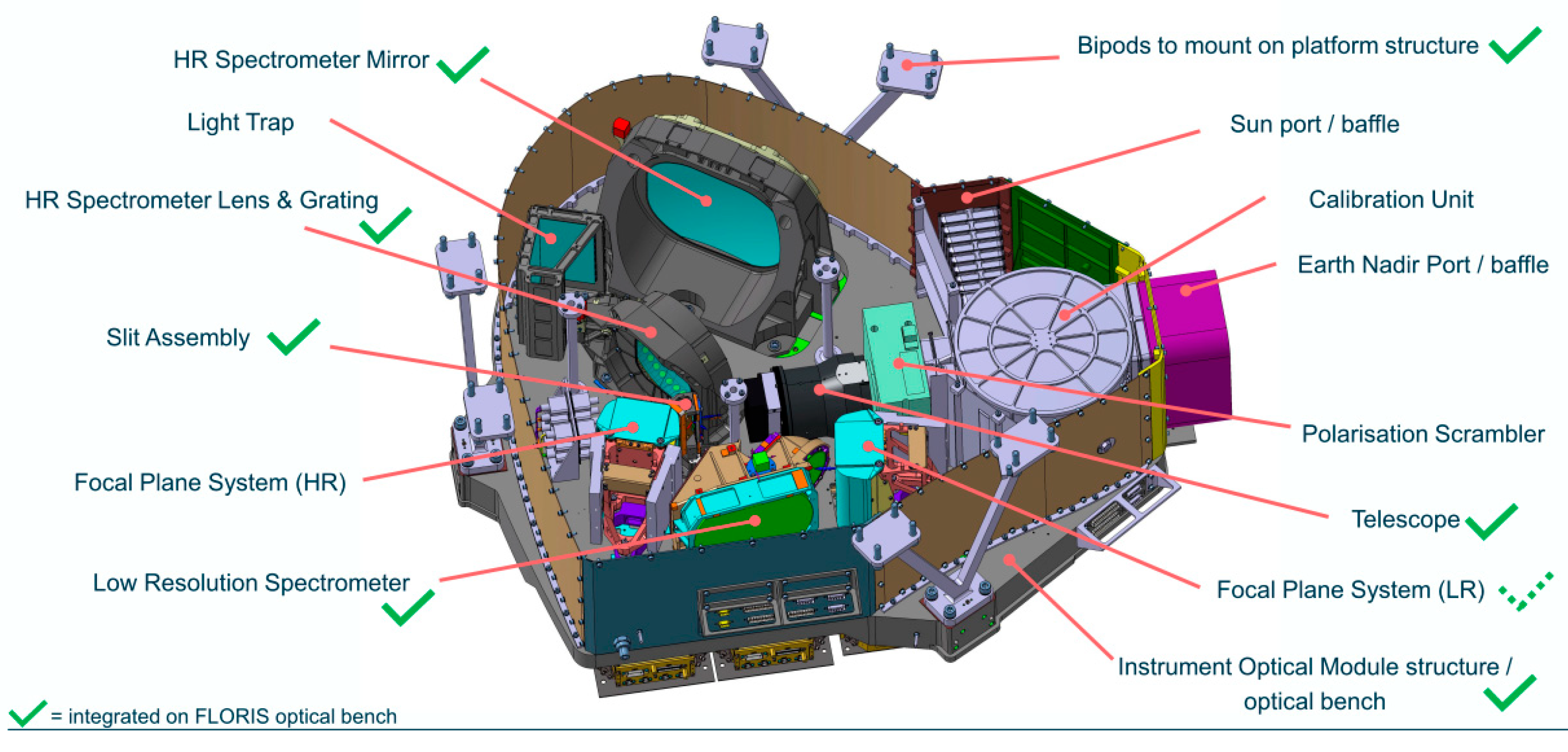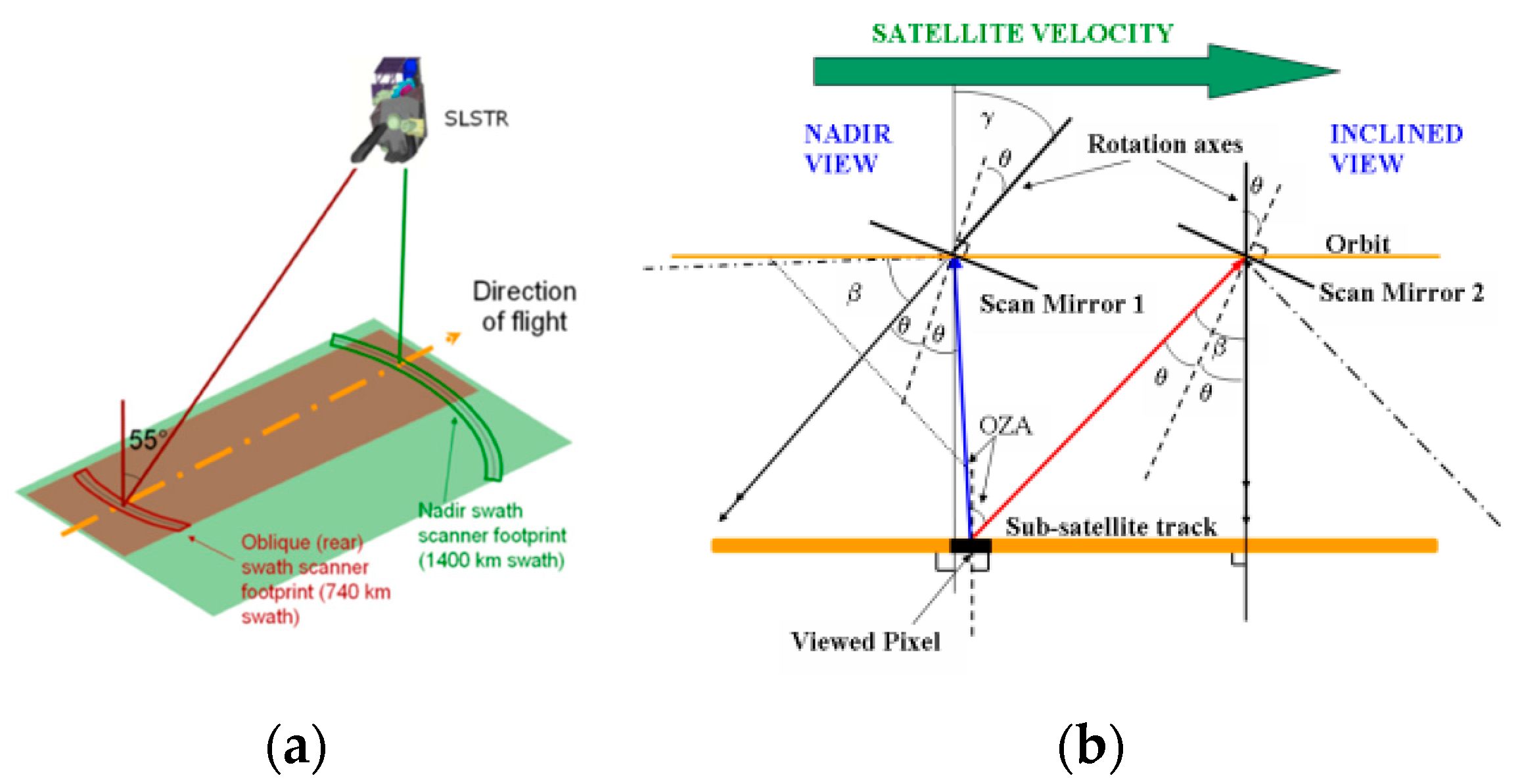1. Introduction
The FLuorescence EXplorer (FLEX) mission, selected for the ESA Earth Explorer EE8 program [
1], will fly in tandem with the Sentinel 3 mission in 2025, taking advantage of data synergy with other visible reflectance (from Ocean & Land Color Imager, called OLCI) and surface temperature data (from Sea and Land Surface Temperature Radiometer, called SLSTR) [
2]. The new measurement of plant fluorescence signals with respect to normal reflectance data allows an early and more direct approach to the diagnosis of the functioning and health status of Earth vegetation. The FLuORescence Imaging Spectrometer (FLORIS) is the FLEX payload [
3]. It will be embarked on a medium-/small-sized satellite and will fly at a height of about 815 km in a sun-synchronous orbit.
SLSTR is a highly accurate infrared radiometer operative in the Sentinel 3 missions (within the Copernicus program) and devoted to Sea and Land Surface Temperature measurements (SST and LST, respectively).
Leonardo is involved as the prime instrument contractor both in the SLSTR and in the FLORIS spectrometer, with Thales Alenia Space acting as the satellite prime contractor.
2. FLORIS Instrument
FLORIS is a pushbroom hyperspectral imager covering the entire visible spectral range (500–780 nm) at a spatial resolution of 300 m and a swath of 150 km by means of two high-spectral resolution spectrometers (0.093 nm for HR 677–780 nm and 0.6 nm for LR 500–758 nm) and a common telescope [
3].
The FLORIS instrument is now under subsystem integration in phase C–D (
Figure 1).
Low spectral and spatial stray light signals are fundamental for fluorescence retrieval and can be achieved thanks to high-efficiency coatings, super-polished surfaces, tight control of particle contamination, holographic gratings, a linear variable filter (LVF), and a correction algorithm. Considering a transition between a white (e.g., cloud) and a dark (e.g., reference vegetation) scene, a max level of stray light of 0.7 mW/m2/sr/nm at level 0 and 0.04 mW/m2/sr/nm at level 1b (after correction) is required for the high-spectral resolution spectrometer (from 677 nm to 780 nm) at a distance of 12 km from the transition. Considering the expected in-flight vegetation signal levels (e.g., 100 mW/m2/sr/nm), the required stray light levels are very stringent because of the order of 0.7% (Level 0) and 0.04% (Level 1b).
In order to perform a stray light correction, the Level 0 stray light can be divided into correctable and not-correctable terms, depending on the availability of input data for correction. The correctable terms are evaluated by using measured In-Field, In-Band, Along-Track, Out-of-Field, and Out-Of-Band FLORIS signals between 697 and 740 nm and from 500 to 677 nm. Out-Of-Band signals less than 500 nm and higher than 780 nm are filtered out by a dedicated band-pass filter. The not-correctable terms are the ones where no FLORIS signal is available: Across-Track Out-of-Field and the extra contamination introduced between calibration and in-flight operations (due to satellite AIV and launch).
The stray light signal is estimated by convolving the instrument response with the measured signals, where the instrument response is obtained by means of an ASAP optical model correlated with measurements performed during a dedicated on-ground calibration campaign.
Then, the correction is obtained by subtracting the estimated stray light from the measured scene signal. Finally, the residual Level 1b stray light signal is represented by the not-correctable stray light with a residual error due to the non-perfect estimation of stray light-correctable terms.
The correction algorithm is currently under assessment. It will be validated during the on-ground calibration campaign and checked in flight by a dedicated instrument operative mode which allows contemporaneously measurements of the lunar disk and the dark space. The instrument stray light will be estimated when looking at the dark space at a certain distance from the sharp transition between the Moon and the dark space.
3. SLSTR Instrument
The SLSTRs have a spatial resolution of 1 km at the sub-satellite point (SSP) for the thermal channels [
2]. Enhanced cloud screening and other products are available with a spatial resolution of 0.5 km at SSP for the three visible and the three SWIR channels.
A dual view design allows for simultaneous observation of the same ground pixel by means of two atmospheric paths in the three nominal infrared bands (S7 = 3.74 ± 0.19 µm, S8 = 10.85 ± 0.45 µm, and S9 = 12.0 ± 0.50 µm). This is essential for achieving optimum correction of atmospheric aerosols and water vapor for SST measurements with 0.3 K accuracy and 0.1 K/decade sensitivity. Two additional fire channels (F1 and F2) with the same spectral bandwidth as the S7 and S8 channels but a higher dynamic range allow for the monitoring of high-temperature events, such as forest fires, at a spatial resolution of 1 km.
The SLSTRs use a conical scanning concept (
Figure 2), similar to the (A)ATSR series. This optimizes radiometric calibration in the infrared bands by allowing constant optical area beam and incidence angles for all scan points when looking at the scene and at the two black bodies (every 0.6 s).
The measured in-flight Noise Equivalent Differential Temperature (NeΔT) during the black bodies observation is compliant with the instrument requirements (
Table 1).
On ground measurements during the calibration activity of the IR channels of SLSTR model A showed a max extra systematic error of 0.16 K and −0.26 K in the S8 and S9 channels, respectively, during the oblique view observations when comparing the instrument brightness temperature with the physical temperature of a reference external blackbody [
4]. This systematic error was attributed to a non-calibrated extra reflection (8–10%) coming from the black coating of the input pupil stop located near the Parabolic Mirror Assembly, which is present only when looking at the scene and not when looking at the black bodies. A correction algorithm has been developed and applied to the measured signals in order to recover this systematic error. Moreover, the black coating was changed in the SLSTR models B-C-D by replacing it with another one with lower reflection (3–5%), and a reduction of about a factor two of the systematic error was obtained, achieving compliance with the 0.2 K radiometric accuracy requirement. The use of the same correction algorithm but with different coefficients can further reduce the error.
4. Tandem Mission with Sentinel-3
The FLEX mission and Copernicus Sentinel 3 satellites will orbit in tandem. This enables FLEX to use Sentinel 3’s optical and thermal sensor data, combining all measurements to evaluate the health status of plants (
Figure 3).
The required information for atmospheric corrections will be provided by Sentinel-3’s OLCI and SLSTR instruments. Moreover, they will contribute to retrieving vegetation information (leaf area index, vegetation temperature, and chlorophyll concentration) useful for retrieving the fluorescence signal.
Author Contributions
Conceptualization, P.C. and R.G.; methodology, P.P.; software, G.B. and G.D.P.; validation, D.N., formal analysis, E.D.L.; writing—original draft preparation, P.C.; writing—review and editing, P.C. and E.D.L. All authors have read and agreed to the published version of the manuscript.
Funding
The activities were funded by European Space Agency in NL and Thales Alenia Space in France, the grant number is [4000118350/16/NL/MP] for FLEX and [1550000977] for SLSTR.
Institutional Review Board Statement
Not applicable.
Informed Consent Statement
Not applicable.
Data Availability Statement
Data sharing is not applicable.
Conflicts of Interest
The authors declare no conflicts of interest.
References
- Drusch, M.; Moreno, J.; Del Bello, U.; Franco, R.; Goulas, Y.; Huth, A.; Kraft, S.; Middleton, E.M.; Miglietta, F.; Mohammed, G.; et al. The Fluorescence Explorer Mission Concept—ESA’s Earth Explorer 8. IEEE Trans. Geosci. Remote Sens. 2017, 55, 1273–1284. [Google Scholar] [CrossRef]
- Coppo, P.; Brandani, F.; Faraci, M.; Sarti, F.; Dami, M.; Chiarantini, L.; Ponticelli, B.; Giunti, L.; Fossati, E.; Cosi, M. Leonardo Spaceborne Infrared Payloads for Earth Observation: SLSTRs for Copernicus Sentinel 3 and PRISMA hyperspectral camera for PRISMA satellite. Appl. Opt. 2020, 59, 6888–6901. [Google Scholar] [CrossRef] [PubMed]
- Coppo, P.; Taiti, A.; Pettinato, L.; Francois, M.; Taccola, M.; Drusch, M. Fluorescence imaging spectrometer (FLORIS) for ESA FLEX mission. Remote Sens. 2017, 9, 649. [Google Scholar] [CrossRef]
- Smith, D.; Barillot, M.; Bianchi, S.; Brandani, F.; Coppo, P.; Etxaluze, M.; Frerick, J.; Kirschstein, S.; Lee, A.; Maddison, B.; et al. Sentinel-3A/B SLSTR Pre-Launch Calibration of the Thermal InfraRed Channels. Remote Sens. 2020, 12, 2510. [Google Scholar] [CrossRef]
| Disclaimer/Publisher’s Note: The statements, opinions and data contained in all publications are solely those of the individual author(s) and contributor(s) and not of MDPI and/or the editor(s). MDPI and/or the editor(s) disclaim responsibility for any injury to people or property resulting from any ideas, methods, instructions or products referred to in the content. |
© 2024 by the authors. Licensee MDPI, Basel, Switzerland. This article is an open access article distributed under the terms and conditions of the Creative Commons Attribution (CC BY) license (https://creativecommons.org/licenses/by/4.0/).








